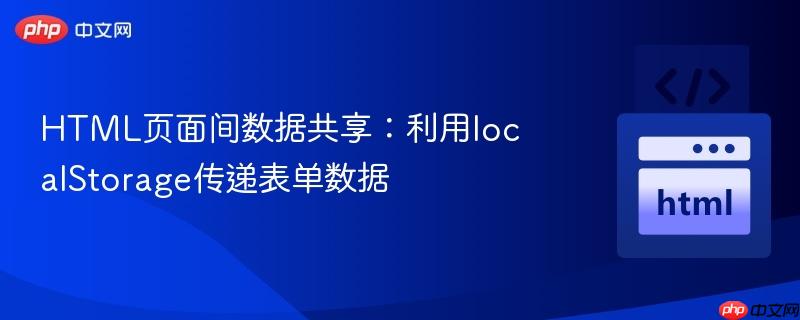
在web开发中,我们经常会遇到需要在不同html页面之间传递数据的场景。例如,用户在一个页面填写了表单信息,然后提交到另一个页面进行展示或处理。直接在html文件中“使用”另一个html文件的类或id是不可能的,因为每个html文件在浏览器中都是一个独立的文档上下文。然而,我们可以通过javascript和web storage api(localstorage或sessionstorage)来实现跨页面的数据共享。本文将重点介绍如何利用localstorage来高效、安全地传递表单数据。
Web Storage API 提供了一种机制,允许Web应用程序在用户的浏览器中存储键值对数据。它主要包括两种类型:
对于需要跨多个会话(即关闭浏览器后数据仍需保留)的数据传递,localStorage是更合适的选择。
在第一个HTML文件(源页面)中,我们需要完成以下步骤:
我们通过document.getElementById()方法获取到具体的表单元素,然后访问其value属性来获取用户输入。为了确保脚本在DOM加载完成后执行,通常会将JavaScript代码放在DOMContentLoaded事件监听器中,或者将<script>标签放在<body>的末尾。
立即学习“前端免费学习笔记(深入)”;
localStorage提供了setItem(key, value)方法来存储数据。key是数据的名称,value是存储的数据。
代码示例:index.html
假设我们有一个用于录入学生信息的表单页面:
<!DOCTYPE html>
<html lang="zh-CN">
<head>
<meta charset="UTF-8">
<meta name="viewport" content="width=device-width, initial-scale=1.0">
<title>学生信息录入</title>
<style>
body { font-family: Arial, sans-serif; margin: 20px; }
form { background: #f4f4f4; padding: 20px; border-radius: 8px; max-width: 400px; margin: auto; }
label { display: block; margin-bottom: 5px; font-weight: bold; }
input[type="text"] { width: calc(100% - 22px); padding: 10px; margin-bottom: 15px; border: 1px solid #ddd; border-radius: 4px; }
button { background-color: #007bff; color: white; padding: 10px 15px; border: none; border-radius: 4px; cursor: pointer; font-size: 16px; }
button:hover { background-color: #0056b3; }
</style>
</head>
<body>
<h1>学生信息录入</h1>
<form id="studentForm">
<label for="studentName">学生姓名:</label>
<input type="text" id="studentName" placeholder="请输入学生姓名" required>
<br>
<label for="studentId">学生学号:</label>
<input type="text" id="studentId" placeholder="请输入学生学号" required>
<br>
<button type="submit">提交学生信息</button>
</form>
<script>
document.addEventListener('DOMContentLoaded', function() {
const form = document.getElementById("studentForm");
form.addEventListener("submit", function(e) {
e.preventDefault(); // 阻止表单默认提交行为,避免页面刷新
const studentName = document.getElementById('studentName').value;
const studentId = document.getElementById('studentId').value;
// 创建一个JavaScript对象来存储学生信息
const studentObj = {
name: studentName,
id: studentId
};
// 将JavaScript对象转换为JSON字符串并存储到localStorage
// "studentInfo" 是存储的键名,可以自定义
localStorage.setItem("studentInfo", JSON.stringify(studentObj));
alert('学生信息已保存,即将跳转到结果页。');
// 提交成功后,可以跳转到另一个页面
window.location.href = 'display_data.html';
});
});
</script>
</body>
</html>在上述代码中:
在第二个HTML文件(目标页面)中,我们需要:
localStorage提供了getItem(key)方法来获取数据。如果存储的是JSON字符串,我们需要使用JSON.parse()将其转换回JavaScript对象。
代码示例:display_data.html
这是用于展示学生信息的页面:
<!DOCTYPE html>
<html lang="zh-CN">
<head>
<meta charset="UTF-8">
<meta name="viewport" content="width=device-width, initial-scale=1.0">
<title>学生信息展示</title>
<style>
body { font-family: Arial, sans-serif; margin: 20px; }
.data-container { background: #e6f7ff; padding: 20px; border-radius: 8px; max-width: 400px; margin: auto; border: 1px solid #91d5ff; }
p { font-size: 18px; margin-bottom: 10px; }
span { font-weight: bold; color: #0056b3; }
.error-message { color: red; font-weight: bold; text-align: center; }
</style>
</head>
<body>
<h1>学生信息详情</h1>
<div class="data-container">
<p>姓名: <span id="displayName"></span></p>
<p>学号: <span id="displayId"></span></p>
</div>
<script>
document.addEventListener('DOMContentLoaded', function() {
// 从localStorage中获取JSON字符串
const studentInfoJSON = localStorage.getItem("studentInfo");
if (studentInfoJSON) {
// 将JSON字符串解析为JavaScript对象
const studentObj = JSON.parse(studentInfoJSON);
// 将数据显示在页面上
document.getElementById('displayName').textContent = studentObj.name;
document.getElementById('displayId').textContent = studentObj.id;
console.log(`在 ${document.title} 页面获取到学生信息:姓名 - ${studentObj.name}, 学号 - ${studentObj.id}`);
} else {
// 如果localStorage中没有找到数据,则显示提示信息
console.log('localStorage中未找到学生信息。');
const container = document.querySelector('.data-container');
if (container) {
container.innerHTML = '<p class="error-message">未找到学生信息,请返回上一页录入。</p>';
}
}
});
</script>
</body>
</html>在上述代码中:
在使用localStorage进行数据传递时,需要注意以下几点:
localStorage和sessionStorage都只能存储字符串。如果需要存储数字、布尔值或复杂对象(如数组、JavaScript对象),必须先使用JSON.stringify()将其转换为JSON字符串,并在读取时使用JSON.parse()将其转换回来。
通过localStorage,我们可以有效地在不同的HTML文件之间传递和共享数据,尤其适用于表单数据的持久化和跨页面展示。关键在于在源页面将数据(特别是JavaScript对象)序列化为JSON字符串并存储,然后在目标页面反序列化并使用。理解localStorage的特性、限制和安全注意事项,将帮助我们构建更健壮、更用户友好的Web应用程序。对于更复杂或更敏感的数据传递需求,可能需要结合后端服务、Cookies或其他前端状态管理库来解决。
以上就是HTML页面间数据共享:利用localStorage传递表单数据的详细内容,更多请关注php中文网其它相关文章!

HTML怎么学习?HTML怎么入门?HTML在哪学?HTML怎么学才快?不用担心,这里为大家提供了HTML速学教程(入门课程),有需要的小伙伴保存下载就能学习啦!




Copyright 2014-2025 https://www.php.cn/ All Rights Reserved | php.cn | 湘ICP备2023035733号